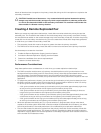
reduce any performance impact to the host application that might occur while any changed data on the
primary virtual disk is copied to the secondary virtual disk.
When a replication relationship is in a suspended state, the primary virtual disk does not make any
attempt to contact the secondary virtual disk. Any writes to the primary virtual disk are persistently logged
in the replication repository virtual disks. After the replication relationship resumes, any data that is written
to the primary virtual disk is automatically written to the secondary virtual disk. Only the modified data
blocks on the primary virtual disk are written to the secondary virtual disk. Full synchronization is not
required.
This example shows the suspend remoteReplicationGroup command:
suspend asyncRemoteReplicationGroup ["asyncRemoteReplicationGroupName"];
The replication relationship group remains suspended until you use the resume
asyncRemoteReplicationGroup command to restart synchronization activities.
This example shows the resume remoteReplicationGroup command:
resume asyncRemoteReplicationGroup ["asyncRemoteReplicationGroupName"];
Deleting A Remote Replication Group
Use the delete asyncRemoteReplicationGroup command to delete one or more replication groups
from the local or remote storage array. The replication group you are attempting to delete must be
empty (contain no virtual disks or replicated pairs) before running this command.
This example shows the delete asyncRemoteReplicationGroup command:
c:\...\smX\client>smcli 123.45.67.88 123.45.67.89
-c delete asyncRemoteReplicationGroup["replication_group_name"];
To delete all replication groups from the local and remote storage arrays, use the delete
allAsyncRemoteReplicationGroups
command.
To delete selected replication groups, separate group names with "":
delete asyncRemoteReplicationGroups ["name1""name2"];
Removing A Virtual Disk Or Repository Virtual Disk From
A Remote Replication Group
Use the remove virtualDisk command to remove either a member virtual disk or repository virtual
disk from an existing replication group. This command can only be run on the local storage array
containing the replication group affected by the command.
The command shown below removes diskname from the replication group named groupname. Using the
optional deleteRepositoryMembers parameter with a value of TRUE also delete the repository virtual
disk members:
remove virtualDisk ["diskname"]
asyncRemoteReplicationGroup="groupname"
deleteRepositoryMembers=TRUE;
94


















